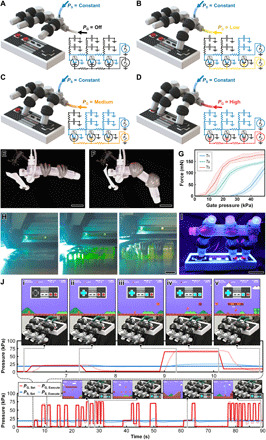Fig. 5. Concepts and results for a preprogrammed, aperiodic fluidic input–based soft robotic hand with integrated fluidic circuitry.

(A to D) Conceptual illustrations and analogous circuit diagrams of the four primary states based on distinct PG magnitudes, while a PS input remains constant. The integrated normally open fluidic transistors include distinct γ properties (γ1 < γ2 < γ3). (E and F) Experimental results for a soft robotic finger with an integrated γ3 fluidic transistor for PS = 20 kPa and PG = (E) 0 kPa and (F) 20 kPa. Scale bars, 2 cm; see also movie S4. Photo credits: Kristen M. Edwards, Jennifer Landry, and Ryan D. Sochol, University of Maryland College Park. (G) Quantified experimental results for fingertip actuation force versus PG for soft robotic finger–fluidic transistor systems with varying γ and PS of 10 kPa. Error bands denote SD. (H) Sequential time-lapse images of the PolyJet 3D printing process. Scale bar, 2 cm; see also movie S5. Photo credit: Joshua D. Hubbard, University of Maryland, College Park. (I) Fabrication results. Scale bar, 2 cm. Photo credit: Joshua D. Hubbard and Kristen M. Edwards, University of Maryland, College Park. (J) Experimental results for completing the first level of the Super Mario Bros. video game in real time in response to a preprogrammed PG input (PS programmed to remain constant). Callouts include the controller activation state, the game state, and an image of the soft robotic hand using the controller corresponding to demonstrative time points; see also movie S6. Photo credit: Joshua D. Hubbard, Ruben Acevedo and Kristen M. Edwards, University of Maryland, College Park.
